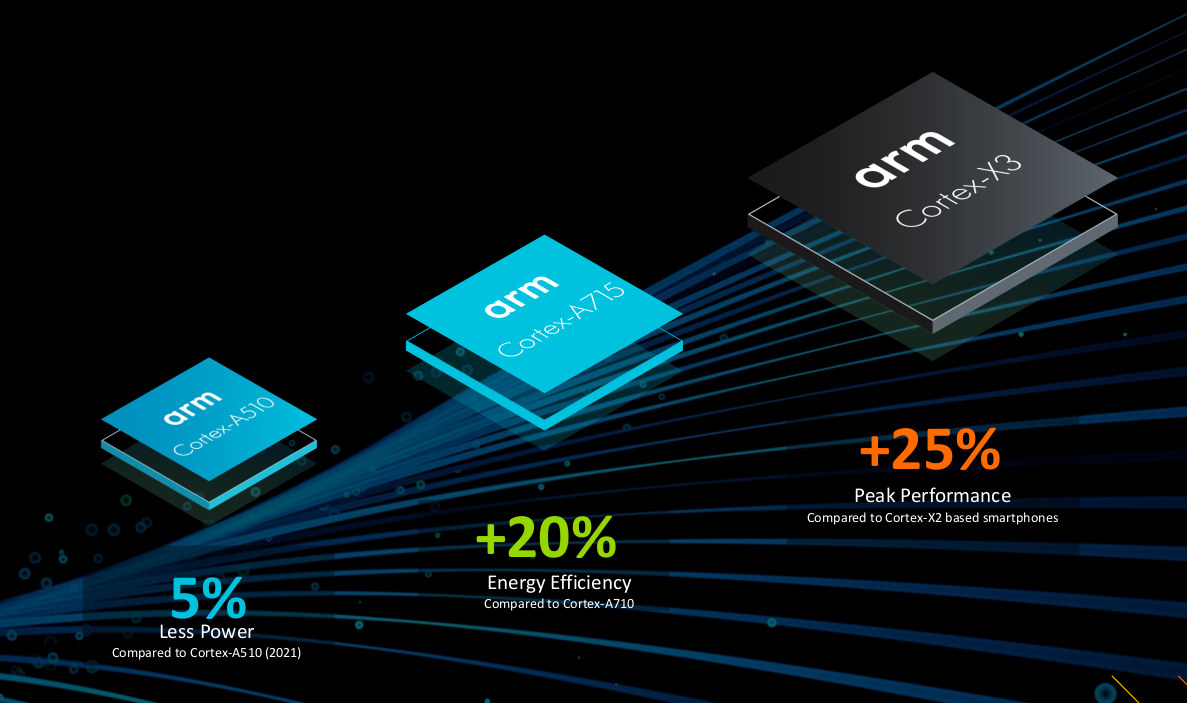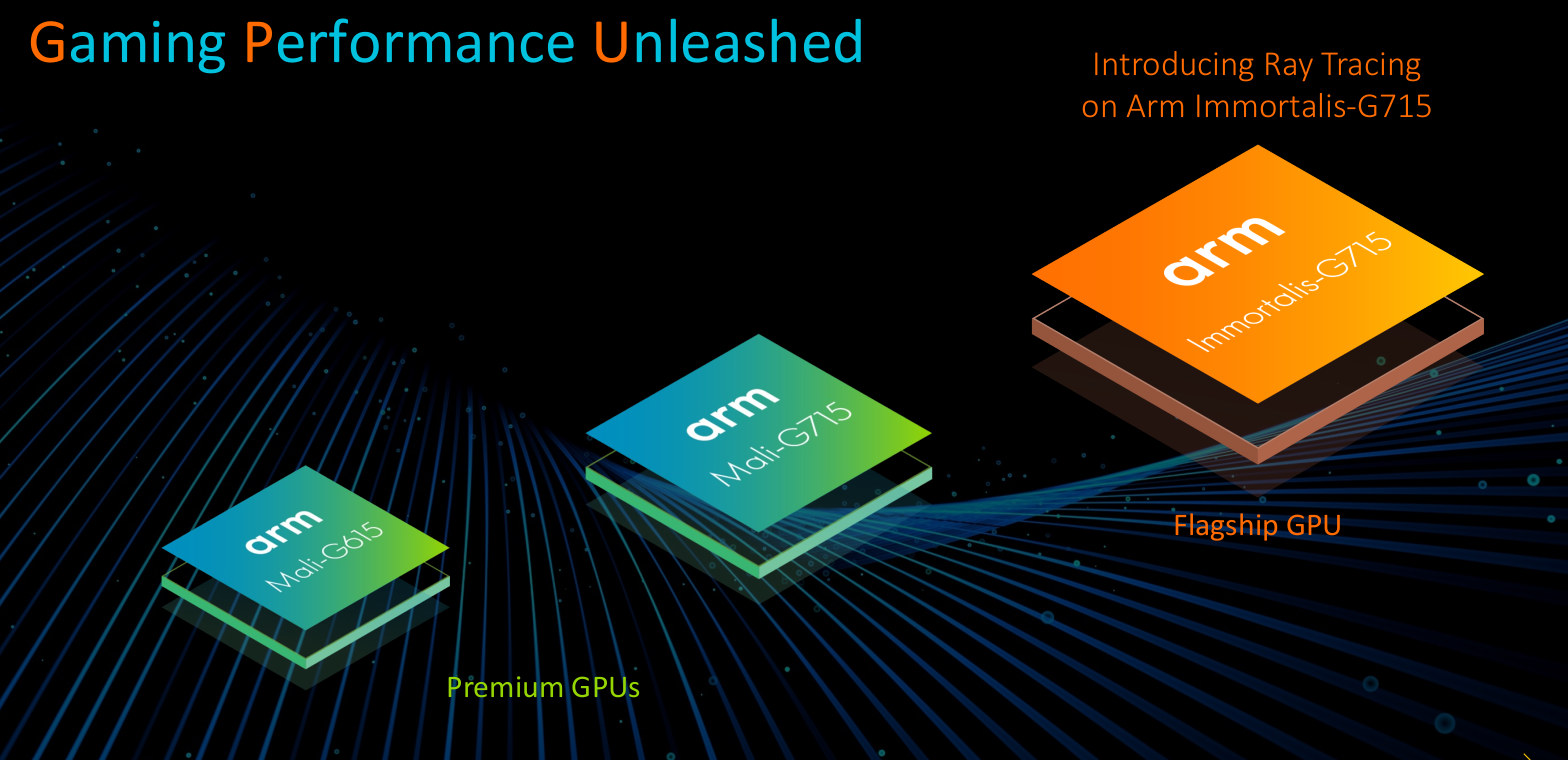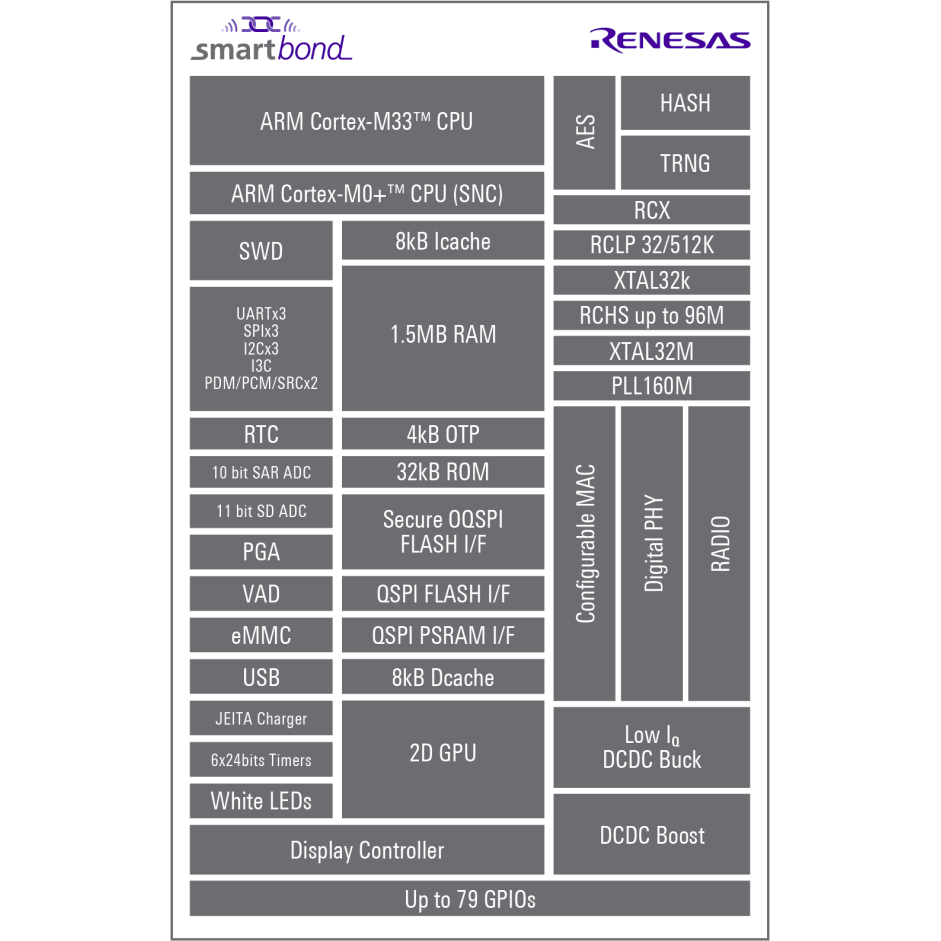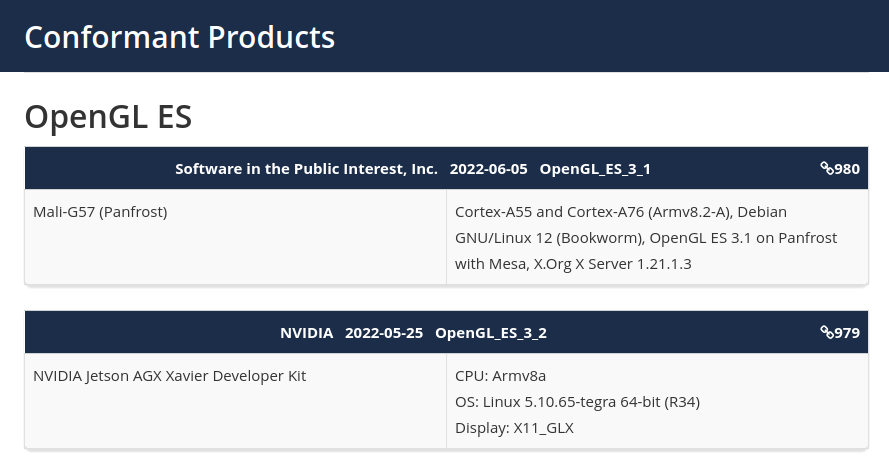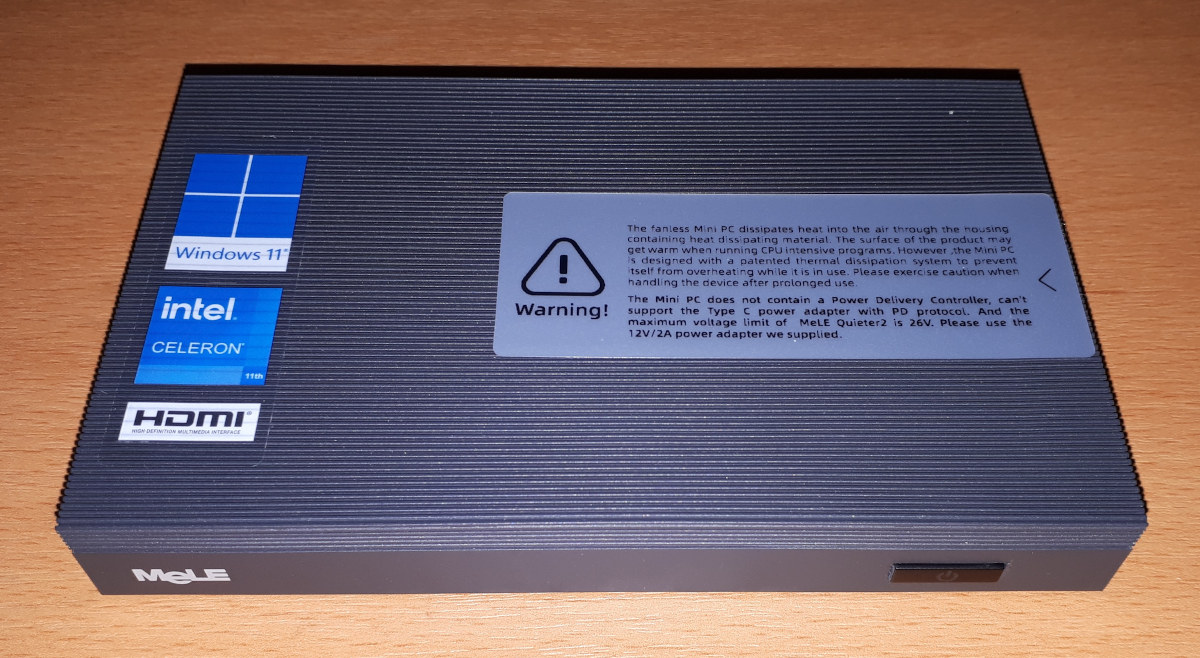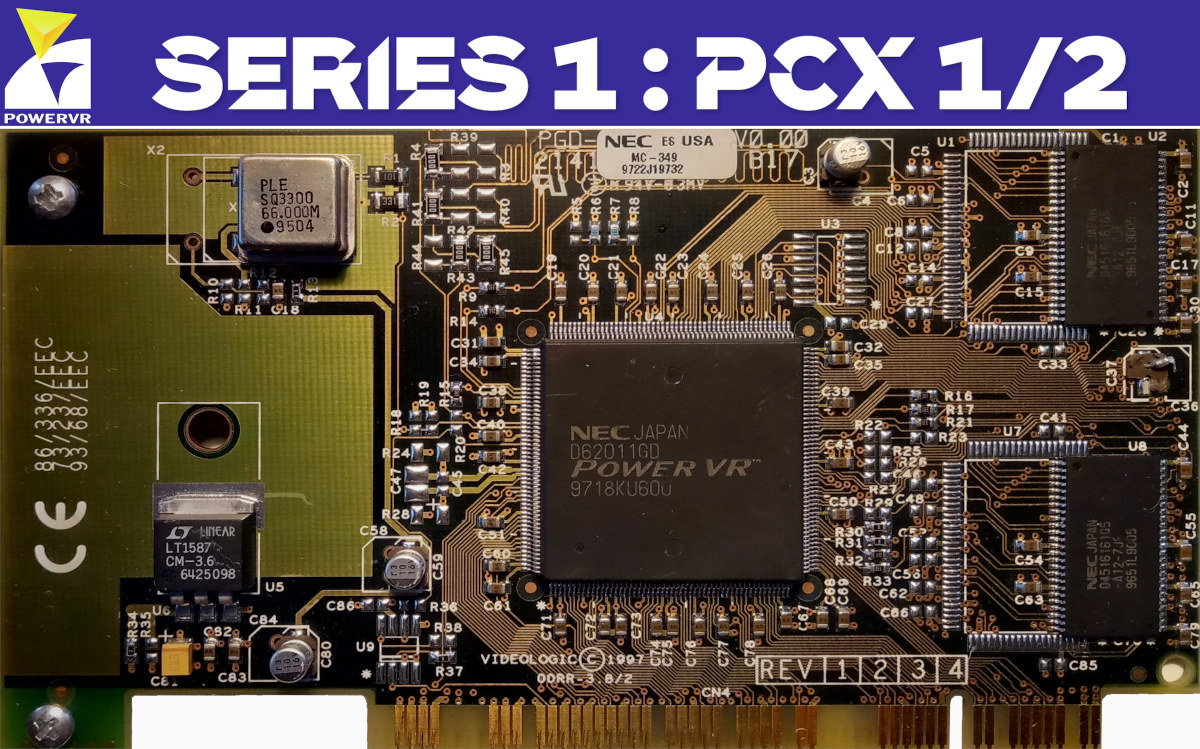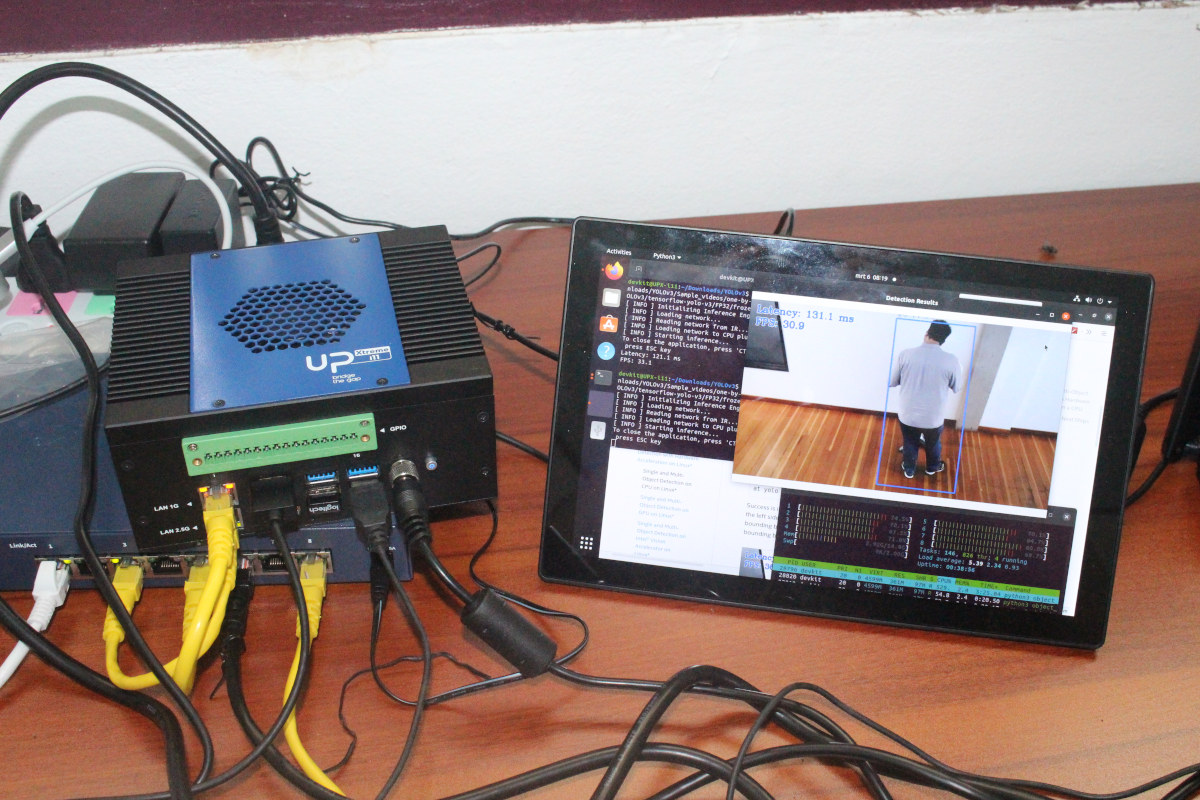Besides announcing the new Immortalis-G715, Mali-G715, and Mali-G615 GPUs, Arm has also introduced the second-generation of Armv9 cores with the Cortex-A715 and Cortex-X3 cores with respectively a 20% energy-efficiency improvement (and smaller 5% performance uplift) over the Cortex-A710 core and a 25% peak performance boost against the Cortex-X2 flagship core. The announcement also includes a “refresh” of the Cortex-A510 core announced last year with a 5% improvement in efficiency and the same level of performance. The Cortex-X3 will also be used in (Windows 11) laptop processors with the single-thread performance improved by up to 34% in that case. Armv9 mobile SoC (Total Compute) in 2023 Future Armv9 flagship mobile SoC worked on this year, and released in 2023 should have a combination of Cortex-X3, Cortex-A715, and Cortex-A510 cores, an Immortalis-G715 GPU, a new DSU-110 “DynamIQ Shared Unit” that supports 50% more cores in CPU clusters (or up to 12 cores […]
Arm Immortalis-G715 GPU supports hardware-based ray tracing
Arm has unveiled the new Immortalis family of flagship GPUs with support for hardware-based ray tracing starting with the Immortalis-G715 GPU, as well as two new premium Mali GPUs namely Arm Mali-G615 and Mali-G715. Software-based ray tracing was already implemented on Arm Mali G710 on SoC’s such as the MediaTek Dimensity 9000, but the hardware-based ray tracing in the Immortalis-G715 delivers over 300 percent performance improvements, and only uses 4% of the shader core area. This will be mostly used in games to generate realistic lighting and shadows as can be seen in the “before vs after” video demo below. While hardware-based ray tracing is only available on the Immortalis-G715 GPU, all three new GPUs feature a new execution engine and support variable rate shading. The Immortalis-G715 flagship GPU will come with 10 or more cores, the Mali-G715 with 6 to 9 cores, and the Mali-G615 with 6 cores […]
Renesas SmartBond DA1470x Bluetooth 5.2 LE SoC features a 2D GPU
I would not usually ask myself “is there a GPU?” in a Bluetooth LE SoC, but that’s exactly what Renesas SmartBond DA1470x Bluetooth 5.2 LE microcontroller offers with a 2D GPU used to accelerate the rendering of user interfaces in wearables, healthcare devices, home appliances with displays, industrial automation and security systems, as well as consoles in e-bikes and gaming equipment. The DA1470x also comes with a Cortex-M33 application core, a Cortex-M0+ sensor node controller, 1.5MB SRAM, and an ultra-low-power hardware VAD for always-on audio processing, as well as various peripherals. Specifications: CPU cores Arm Cortex-M33 core @ up to 160 MHz for the application Arm Cortex-M0+ core acting as a sensor node controller (SNC) GPU – 2D GPU for advanced graphics processing Memory – 1.5MB SRAM Storage 4 kB OTG, 32KB ROM on-chip Decrypt-on-the-fly Octa/Quad SPI flash interface Dedicated QSPI PSRAM and QSPI flash interfaces eMMC interface supporting up […]
Think Silicon NEOX RISC-V GPU offers 3D graphics or AI acceleration
Think Silicon NEOX GPU family with models optimized for graphics (NEOX|G) or artificial intelligence (NEOX|A) is based on the RISC-V RV64C ISA instruction set with adaptive NoC, and offers up to 64 cores delivering up to 409.6 GFLOPS at 800MHz with support for FP16, FP32 and optionally FP64 and SIMD instructions. The NEOX GPUs can be integrated into microcontrollers, crossover processors, and even more powerful application processors, and target AI, IoT/Edge, and media processing in consumer and industrial devices. Each shader of the GPU is a programmable 64-bit RISC-V (RV64GC) core running a real-time operating system (RTOS) and the GPU is supported by lightweight graphics and machine learning frameworks. The multi-threaded GPU system can be customized for graphics, machine learning, vision/video processing, and general-purpose compute (GPGPU) workloads. The solution is meant to be integrated into 32-bit SoCs designed for smartwatches, augmented reality (AR) eyewear, video surveillance, and smart display terminals […]
Panfrost now offers a fully-conformant OpenGL ES 3.1 implementation for Mali-G57 (Valhall) GPU
The Mali-G57 GPU part of the Valhall family, and found in several Arm processors such as MediaTek MT8192 and MT8195 SoC powering some Chromebooks, is now supported by the Panfrost open-source driver with a fully-conformant OpenGL ES 3.1 implementation. Last year, Collabora updated Panfrost with support for OpenGL ES 3.1 on Midgard (Mali T760 and newer) and Bifrost (Mali G31, G52, G76) GPUs, and also announced having started working on Valhall GPUs. One part of the work was done in the summer of 2021 with some reverse-engineering work on Mali-G78 GPU’s instruction set, and this has culminated with a fully-conformant OpenGL3.1 for Mali-G57 GPU. Interestingly, it’s not been released by Collabora directly, but through an organization called “Software in the Public Intenerest, Inc.” (or SPI for shorts) which happens to be a non-profit organization incorporated on June 16, 1997, and described as: a non-profit corporation registered in the state of […]
MeLE Quieter3Q Review – Ultra-thin fanless mini PC tested with Windows 11, Ubuntu 22.04
MeLE has released a new and updated version of the Quieter mini PC called the Quieter3Q. Like before, it is a passive mini PC but now features the latest low-powered Intel Celeron Jasper Lake CPU and an upgraded PCIe 3.0 x2 M.2 2280 NVMe SSD slot. MeLE has kindly sent one for review and I’ve looked at performance running both Windows and Ubuntu and connecting an eGPU. MeLE Quieter3Q Hardware Overview The MeLE Quieter3Q is physically the same as before consisting of a 131 x 81 x 18.3mm (5.16 x 3.19 x 0.72 inches) rectangular plastic case with a metal base plate. The top half of the case is finely grooved to mimic the fins of a heat spreader but is made of plastic rather than metal to allow reception to the WiFi antennas as one is directly connected to it. As a passively cooled mini PC, it uses Intel’s […]
Imagination open sources PowerVR Series 1 GPU drivers
Saying that Imagination Technologies is not exactly popular in the open-source community would be an understatement, but the company has just open-sourced the driver source for Power Series 1 GPUs namely Midas Arcade, PCX1, and PCX2. If those names do not ring a bell, it might be because some of you may not have been born when PowerVR GPUs were first unveiled in 1995, and launched in products in 1996/1997. Developed jointly by VideoLogic and NEC, PowerVR was touted as the “future of high-quality 3D graphics for the next generation of interactive entertainment”, “whether you are developing 3D systems for console, PC, or arcade systems”. VideoLogic was renamed Imagination Technologies in 1999. The PowerVR PCX1/PCX2 GPUs were notably used in the Apocalypse 3D/3Dx and Matrox M3D graphics cards with support for Direct3D and playing games such as Tomb Raider or Wipeout XL on Windows PCs. I can remember playing those […]
UP Xtreme i11 mini PC review with Ubuntu 20.04, Edge Insights for Vision
UP Xtreme i11 is both a single board computer and a mini PC powered by an Intel Tiger Lake processor and designed for industrial edge applications. I received the one sample of the mini PC called “UP Xtreme i11 Edge Compute Enabling Kit” last December based on an Intel Core i7-1185GRE processor, fitted with 16GB RAM, a 128GB SSD, and pre-loaded with Ubuntu 20.04 operating system. I’ve now had more time to play with the system, and I’ll report my experience with Ubuntu 20.04 and Edge Insights for Vision, a computer vision framework that’s part of the getting started guide. The latter was missing from my package possibly because customs opened the package, and forgot to put it back in. The most important part is “devkit” is used as username and password. Software for UP Xtreme i11 and Fan Control While Ubuntu 20.04 is pre-installed on the mini PC, it’s […]


